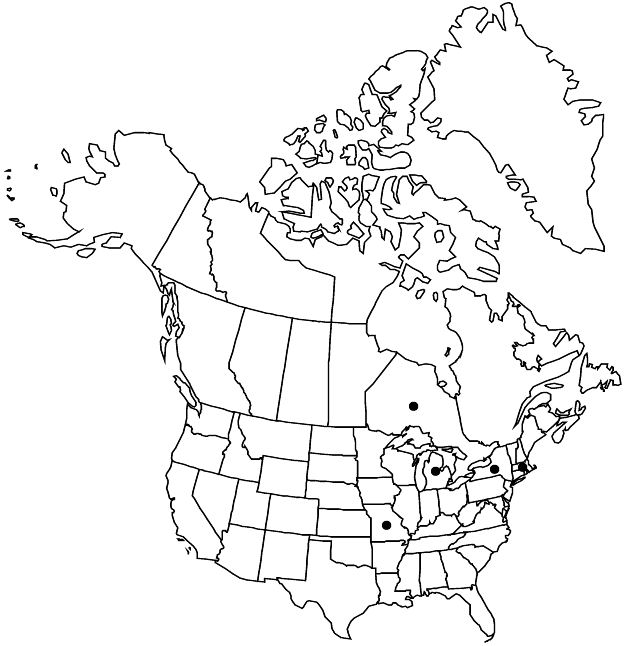Difference between revisions of "Crataegus cognata"
Rhodora 5: 58. 1903.
FNA>Volume Importer |
FNA>Volume Importer |
||
| Line 15: | Line 15: | ||
|name=Crataegus aperta | |name=Crataegus aperta | ||
|authority=Sargent | |authority=Sargent | ||
| + | |rank=species | ||
}} {{Treatment/ID/Synonym | }} {{Treatment/ID/Synonym | ||
|name=C. patrum | |name=C. patrum | ||
|authority=Sargent | |authority=Sargent | ||
| + | |rank=species | ||
}} {{Treatment/ID/Synonym | }} {{Treatment/ID/Synonym | ||
|name=C. pruinosa var. cognata | |name=C. pruinosa var. cognata | ||
|authority=(Sargent) J. B. Phipps | |authority=(Sargent) J. B. Phipps | ||
| + | |rank=variety | ||
}} {{Treatment/ID/Synonym | }} {{Treatment/ID/Synonym | ||
|name=C. pruinosa var. latisepala | |name=C. pruinosa var. latisepala | ||
|authority=(Ashe) Eggleston | |authority=(Ashe) Eggleston | ||
| + | |rank=variety | ||
}} | }} | ||
|hierarchy=Rosaceae;Rosaceae subfam. Amygdaloideae;Rosaceae tribe Gillenieae;Crataegus;Crataegus sect. Coccineae;Crataegus (sect. Coccineae) ser. Pruinosae;Crataegus cognata | |hierarchy=Rosaceae;Rosaceae subfam. Amygdaloideae;Rosaceae tribe Gillenieae;Crataegus;Crataegus sect. Coccineae;Crataegus (sect. Coccineae) ser. Pruinosae;Crataegus cognata | ||
| Line 49: | Line 53: | ||
-->{{#Taxon: | -->{{#Taxon: | ||
name=Crataegus cognata | name=Crataegus cognata | ||
| − | |||
|authority=Sargent | |authority=Sargent | ||
|rank=species | |rank=species | ||
| Line 64: | Line 67: | ||
|publication year=1903 | |publication year=1903 | ||
|special status=Endemic | |special status=Endemic | ||
| − | |source xml=https://jpend@bitbucket.org/aafc-mbb/fna-data-curation.git/src/ | + | |source xml=https://jpend@bitbucket.org/aafc-mbb/fna-data-curation.git/src/f50eec43f223ca0e34566be0b046453a0960e173/coarse_grained_fna_xml/V9/V9_984.xml |
|subfamily=Rosaceae subfam. Amygdaloideae | |subfamily=Rosaceae subfam. Amygdaloideae | ||
|tribe=Rosaceae tribe Gillenieae | |tribe=Rosaceae tribe Gillenieae | ||
Revision as of 22:45, 16 December 2019
Shrubs, 20–40 dm. Stems: main branches often suberect; twigs: new growth reddish brown, 1-year old purple-brown, older dark gray; thorns on twigs numerous, straight to slightly recurved, 2-years old black, shiny, ± slender, 3–5 cm. Leaves: petiole length 28–36% blade, eglandular or with 1–2 glands distally; blade ovate, 3.5–5.5 cm, subcoriaceous, base broadly cuneate to truncate, lobes 3(or 4) per side, sinuses shallow, lobe apex subacute, margins crenate-serrate, veins 5–7 per side, apex subacute, surfaces glabrous. Inflorescences 4- or 5-flowered; branches glabrous; bracteole margins short-stipitate-glandular. Flowers 17–19 mm diam.; hypanthium glabrous; sepals narrowly triangular, 5 mm, base broad, margins subentire, abaxially glabrous; stamens 20, anthers white, 0.6–0.8 mm; styles 3 or 4. Pomes green with pink or purple pruinosity, becoming orange-red or crimson, 8–10 mm diam.; flesh thin; sepals on collar, spreading-reflexed; pyrenes 3 or 4. 2n = 51.
Phenology: Flowering Apr–May; fruiting Sep–Oct.
Habitat: Successional fields, fencerows, brush, open wood margins
Elevation: 50–300 m
Distribution

Ont., Mass., Mich., Mo., N.Y.
Discussion
Crataegus cognata in the strict sense occurs from Michigan to Massachusetts with the southern limits poorly understood. Specimens from Missouri with large (5–7 cm) leaf blades and no or only weakly developed lobes should be checked against C. pruinosa var. magnifolia.
Crataegus perjucunda Sargent, native to Middlesex County, Ontario, is a distinctive local species similar to C. cognata but with shorter (2–3 cm) and finer thorns as well as relatively wider leaves (length/width = 1.2).
Selected References
None.